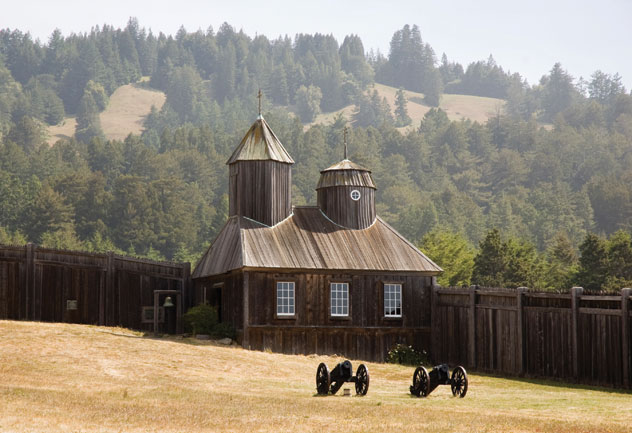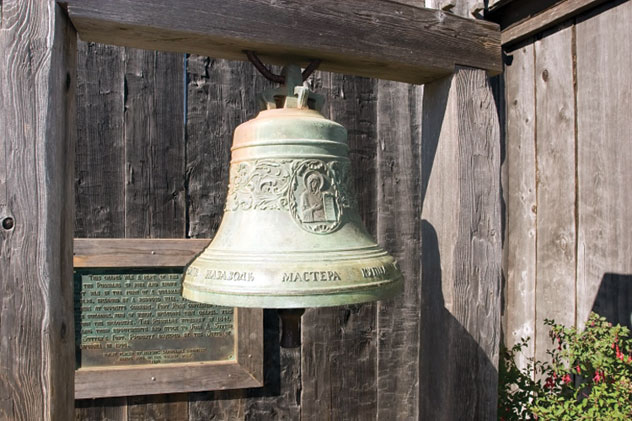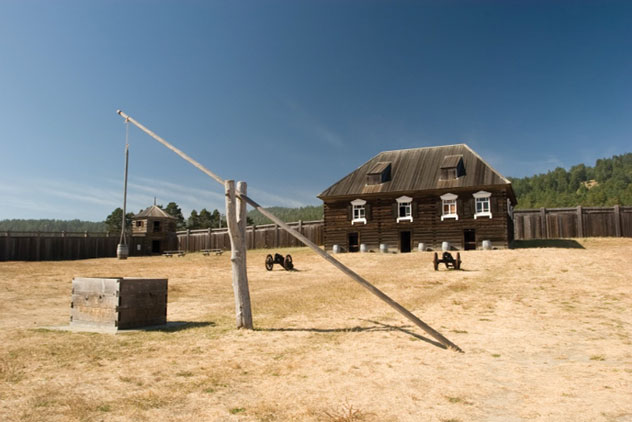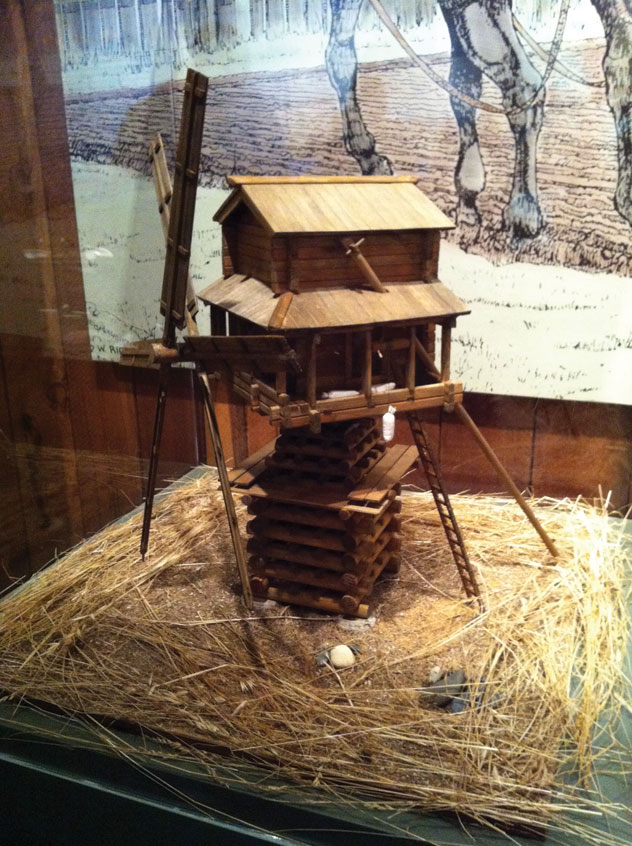TRAVEL:
History Beckons: Fort Ross, California
Our destination this month is one of California’s most historic and little-known venues, Fort Ross State Park. But, this year is an extra-special time to visit this little-known foundation of California’s birth, writes travel editor Al Auger.

(Above): The building, cannons and grounds of Fort Ross.
No matter the destination, when cruising California’s famed Highway 1 in either direction, there are certain obligations one must consider (see Whale Watch Inn, Siliconeer, April 2008). Begin with your mode of transportation; we began astride a road-conquering Corvette. Shut off Traction Control and free the beast. Day of the trip: always a weekday; Highway 1 can be empty, the curves and countryside open and inviting. Our destination is one of California’s most historic and little-known venues, Fort Ross State Park. But, this year is an extra-special time to visit this little-known foundation of California’s birth.
Fort Ross is celebrating its 200th birthday, importunely when California State Parks are burdened by a shallow pocket of money — or scandal. Founded by the Russian-American Company in 1812, it thrived until 1841 with a mixed population of Russians, Native Alaskans, Californians and Creoles (a mix of Russian and native ancestry), were also successful farmers supplying their outposts in Alaska and trading with the Mexican government in Monterey and numerous other nations plying the rich coast.
Louise and I have hardly lost the Golden Gate Bridge from our rear-view mirror as Mom Nature begins her show. We’re skirting Muir Woods, heading to Bolinas and the overwhelming Point Reyes National Seashore. On our left is Tomales Bay, the gentle wind rippling the blue surface and fishing boats bobbing in a slow ballet. Next up the never-changing villages of Fallon and Valley Ford. Slip through Occidental — we are sure to stop here on the return for a family-style dinner at the Union Hotel, then Jenner at the mouth of the Russian River, the first landmark telling us Fort Ross is just up the road.

(Above): The rustic bell at Fort Ross, Calif.
Sitting on a high bluff overlooking the Pacific Ocean, the Russian fur trading and colonization of this far west corner of Sonoma County played big in the beginning of Northern California’s entry into the United States at approximately the same time the Spanish and Mexican governments were changing the rest of California south from Monterey to Mexico.
This drama began with Russia’s eastern expansion crossing what now is the Bering Straits and landed on the edge of Alaska in 1741. What they discovered was a Mother Lode of otters and fur seals, whose pelts were in great demand throughout Russia and Europe. At one time, Russian entrepreneurs were exporting 62,000 fur pelts annually from Alaska. Naturally, this bonanza and wholesale slaughter could last only so long. With the decimation of the fur-bearing seals and otters off the coast of Alaska and the destruction of their company fortress at Sitka, the newly created Russian-American Company searched the coast southward, building a temporary settlement at Bodega Bay — called Rumiantsev Bay by the Russians. By 1803 they found the coast of California flourished with otters and fur seals. Between 1808 and 1811 the Russians, along with a large hunting party of Native Alaskans, scouted many possible permanent sites “New Albion,” their name for California based on Sir Francis Drake‘s designation. Deputy Alexandrovich Kuskov selecting a high cape overlooking the Pacific Ocean and a protected cove where ships could anchor and deliver supplies. The empty ships were then reloaded with pelts and other necessary goods destined for the Russian settlements in Alaska and the European trade.
Thus was born Fort Ross, who’s very existence played some of the most important roles in the creation of California, long before the Gold Rush. When the fort was officially opened, there were an estimated 25 to 100 Russians and 50 to 125 Native Alaskans and others living in the fort at any given time.

(Above): The old well at Fort Ross, Calif.
Our “Plan-A” held sway, a Lindsay-blue sky and scudding, puffy white clouds overhead as we took command of sinuous Highway 1. All that changed as we turned into the entry of Fort Ross. Before us lay a stark, wooden fort layered with swirling fog, creating a surreal landscape. As earlier agreed, we grabbed our blanket and picnic basket and took the trail down the bluff to the protected cove. Cold white wine, fruit and cheese and wonderful company. Sitting on the beach looking out to the calm waters of the Pacific Ocean, we conjured up visions of tall ships anchored off shore while crews rowed large boats laden with supplies and then returning with layer upon layer of pelts and other goods destined for Alaska and Russia.
Refreshed, we returned the picnic gear to the Corvette and began our tour of an exotic California history unfamiliar to so many. Stark, bleak, desolate, are only three descriptions of what lies before you at entry. The large field is completely surrounded by a tall, rough-hewn wooden fence with two blockhouses at strategic corners. Due to the wear and tear of time, fire and vandalism, the only original building left is the Rotchev House, also known as the Commandant’s House. This should be the first visited as it contains valuable historical material and information that will help you understand what is there and what is no longer there.
Outside the Fort, in its heyday, was a Sloboda, or free man’s village of 24 rough dwellings. Nearby were communal kitchens, sleds and bathhouses. Adding to the depth of times past and the human factor is the fog-shrouded cemetery outside the stockade with its 270 orthodox crosses. Over its’ years of existence as a Russian settlement its population was a polyglot of cultures consisting of Russians, Native Alaskans, Californians and Cajuns (of mixed Russian and Native lineage). Louise and I, like most everyone else, believed these hardy souls spent their life in these far flung outposts swaddling the elite of Russia and Europe in fine furs supplied by the herds of seals and otters that populated the coast from California to Alaska.

(Above): Miniature replica of windmill at Fort Ross - Stolbovki. [Photo: WIKIMEDIA COMMONS]
Truth be told, these hardy souls erected California’s first windmills, were proficient in shipbuilding, farming to supply their colonies in the North and the resident scientists were the first to document California’s cultural and natural history. They also created a successful trade business with the Spanish and Mexican governments in Monterey and multi-national ships that regularly plied the west coast of Mexico to Alaska. When the Russians became a relevant force in Northern California, the Spanish in Monterey realized this could be an obstacle to their on-going colonization plans and quickly began moving into what today is the San Francisco Bay Area, Sonoma and Solano Counties.
Having this history with you as you begin the tour is of utmost importance. Exiting the Commandant’s House, before you is a stark, seemingly uninteresting field devoid of structures other than the Commandant’s House, the church and two corner blockhouses. But, pre-armed with the history, graphics and schematics, the centuries of what was is palpable.
As we leisurely began our tour, Louise had to mention, “I’m really impressed by the reconstruction. We must come back as they continue the work still to be done.” This was a result of notices explaining the ongoing research partnership with the Russian government archives that will correct mistakes made during the “Cold War” and add more provenance to future reconstruction. Scattered around the field are cannons from the days of occupation. Looking out the narrow windows of the blockhouses, one could easily see what a nearly impregnable site Fort Ross was. Sitting high on the bluff with the Pacific Ocean at its backside and the high fencing facing wide-open fields, interlopers would have difficulty sneaking up from any angle.
The most interesting is the Orthodox church, its Spartan construction of dark wood with small windows letting in little light is a perfect image of the hard scrabble life this lonely colony must of endured. This is where the ghosts of Fort Ross come alive, the heart of their daily lives where, each Sunday, their weekly toil was forgotten and the promise of another, joyful life, awaited. Here too, were held communal meetings, a place of quiet musing, after a hard day’s labor.
We sat in one of the pews and quietly tried to absorb the weight of the history so heavy around us and what it wrought over the ensuing years. We were sitting where the community of adventurers, farmers, hunters put down the first roots of what was to become the most historic and bucolic region that gave the coming state of California its’ signature: the Golden State.
As we headed for the village of Occidental and a bountiful family-style dinner, we shared our thoughts of what we had just experienced. The conversation lasted as the miles rolled beneath us. It was the first of many visits to this extraordinary venue of history, beauty and natural world which never seems to change.
|